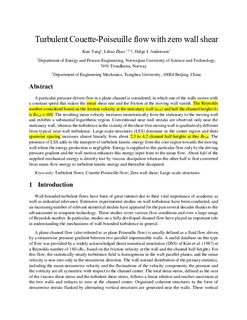| dc.contributor.author | Yang, Kun | |
| dc.contributor.author | Zhao, Lihao | |
| dc.contributor.author | Andersson, Helge Ingolf | |
| dc.date.accessioned | 2018-04-26T08:01:14Z | |
| dc.date.available | 2018-04-26T08:01:14Z | |
| dc.date.created | 2016-12-14T12:46:24Z | |
| dc.date.issued | 2017 | |
| dc.identifier.citation | International Journal of Heat and Fluid Flow. 2017, 63 14-27. | nb_NO |
| dc.identifier.issn | 0142-727X | |
| dc.identifier.uri | http://hdl.handle.net/11250/2496055 | |
| dc.description.abstract | A particular pressure-driven flow in a plane channel is considered, in which one of the walls moves with a constant speed that makes the mean shear rate and the friction at the moving wall vanish. The Reynolds number considered based on the friction velocity at the stationary wall (uτ,S) and half the channel height (h) is Reτ,S = 180. The resulting mean velocity increases monotonically from the stationary to the moving wall and exhibits a substantial logarithmic region. Conventional near-wall streaks are observed only near the stationary wall, whereas the turbulence in the vicinity of the shear-free moving wall is qualitatively different from typical near-wall turbulence. Large-scale-structures (LSS) dominate in the center region and their spanwise spacing increases almost linearly from about 2.3 to 4.2 channel half-heights at this Reτ,S. The presence of LSS adds to the transport of turbulent kinetic energy from the core region towards the moving wall where the energy production is negligible. Energy is supplied to this particular flow only by the driving pressure gradient and the wall motion enhances this energy input from the mean flow. About half of the supplied mechanical energy is directly lost by viscous dissipation whereas the other half is first converted from mean-flow energy to turbulent kinetic energy and thereafter dissipated. | nb_NO |
| dc.language.iso | eng | nb_NO |
| dc.publisher | Elsevier | nb_NO |
| dc.title | Turbulent Couette–Poiseuille flow with zero wall shear | nb_NO |
| dc.type | Journal article | nb_NO |
| dc.description.version | submittedVersion | nb_NO |
| dc.source.pagenumber | 14-27 | nb_NO |
| dc.source.volume | 63 | nb_NO |
| dc.source.journal | International Journal of Heat and Fluid Flow | nb_NO |
| dc.identifier.doi | 10.1016/j.ijheatfluidflow.2016.11.011 | |
| dc.identifier.cristin | 1412668 | |
| dc.relation.project | Notur/NorStore: NN2649K | nb_NO |
| dc.relation.project | Norges forskningsråd: 250744 | nb_NO |
| dc.relation.project | Notur/NorStore: NS2649K | nb_NO |
| dc.description.localcode | This is a submitted manuscript of an article published by Elsevier Ltd in International Journal of Heat and Fluid Flow, 13 December 2016. | nb_NO |
| cristin.unitcode | 194,64,25,0 | |
| cristin.unitname | Institutt for energi- og prosessteknikk | |
| cristin.ispublished | true | |
| cristin.fulltext | preprint | |
| cristin.qualitycode | 1 | |
